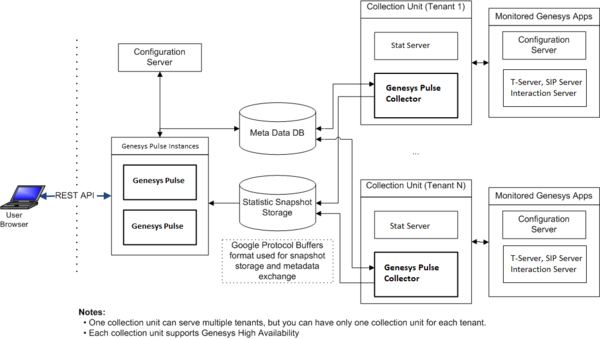Architecture and Components
Genesys Pulse is an application that enables at-a-glance views of real-time contact center statistics within the graphical user interface. Genesys Pulse uses widgets to display user-defined List, Donut, Key Performance Indicator (KPI), or Grid charts of statistics for objects.
Using Genesys Pulse you can:
- Create widgets from predefined and user-defined templates for a fast and easy text or graphical presentation of selected or user-defined object statistics.
- Monitor the current state and activity of contact center objects to help make decisions about staffing, scheduling and call routing strategies.
Contents
Genesys Pulse Architecture
Major aspects of Genesys Pulse are shown in the following Genesys Pulse Architecture diagram:
Genesys Pulse Collector
Genesys Pulse Collector is a background near-realtime statistical data collection and processing engine. It performs the following activities:
- Reads the metadata from the Genesys Pulse database upon startup and whenever changes are made to report definitions in Genesys Pulse.
- Uses the report definitions stored in the Genesys Pulse database to determine which statistics and objects to include.
- Creates snapshots with current data from Stat Server and formula-based statistics calculated by Genesys Pulse Collector, on the specified file system for reference by Genesys Pulse.
- Maintains a constant connection with Configuration Server to retrieve changes, additions, and deletions to configuration objects.
Genesys Pulse
Genesys Pulse performs the following activities:
- Handles user authentication and permissions validation.
- Filters and delivers report data according to the permissions and tenancy of the user who is requesting the data.
Displays report content in widgets, such as the listing and content of reports.
- Saves the report definitions to the Genesys Pulse Database, which it shares with Genesys Pulse Collector.
See the Genesys Pulse User's Guide to learn how to operate this user interface. This is also accessible from within the software, when you click help.
High Availability
See the Genesys Pulse Hardware Sizing and Performance Information for an example of High Available (HA) architecture.
High Availability Failure Scenarios
The following failure scenarios apply to HA configurations.
Stat Server
The Backup Stat Servers take over immediately. There are an HA pair of Stat Servers running for each business. The user experience is minimal due to the Primary and Backup configuration (two active chains), therefore the stats are not reset.
Genesys Pulse Collector
Genesys Pulse Collectors run in Active and Active mode.
Genesys Pulse reads the data from the Genesys Pulse Collector to which it is connected.
When a Genesys Pulse Collector fails, Genesys Pulse either cannot serve users and the load balancer routes users to the other Genesys Pulse or, if you configured WebDAV, Genesys Pulse reads snapshots from the other Genesys Pulse Collector through WebDAV.
This also applies to Genesys Pulse Collector in cluster configuration, only with more nodes.
DB Server
The Backup DB Server takes over immediately. There are a pair of DB Servers for each business running as an HA pair. This failover is invisible to users.
Genesys Pulse Instance
If a Genesys Pulse instance fails, the load balancer is responsible for redirecting the user request to the other Genesys Pulse instances.
If the Genesys Pulse instance fails while the supervisor is connected, the load balancer is still responsible for redirecting the user session to the other Genesys Pulse instances and the login page is displayed. The second active Genesys Pulse instance takes over and no statistics are lost. There are a pair of Genesys Pulse for each business running in Active and Active mode.
Database Failure
To ensure the uninterrupted operation of databases for Genesys Pulse use database cluster solutions. For information about supported databases, see the Genesys Supported Operating Environment Reference.
Genesys Framework Components
Genesys Pulse interacts with several products within the Genesys Framework to provide real-time snapshots of contact center data.
Configuration Server
Configuration Server provides the following data to Genesys Pulse Collector:
- Information about the existence of contact center objects (for example, tenants, agents, places, calling lists, or campaigns)
- Statistical parameters (for example, time ranges, time profiles, filters, and statistical types)
- Information about changes to contact center objects (for example, a deleted agent, a renamed queue, or a new Agent Group).
Genesys Pulse Collector uses this data to provide content for Genesys Pulse.
Both Genesys Pulse and Genesys Pulse Collector connect to Configuration Server in order to retrieve their own configuration.
Stat Server
Stat Server tracks information about customer interaction networks (contact center, enterprise-wide, or multi-enterprise telephony and computer networks). Stat Server also converts the data accumulated for directory numbers (DNs), agents, agent groups, and non-telephony-specific object types, such as email and chat sessions, into statistically useful information, and passes these calculations to other software applications that request data.
As a client of Stat Server, Genesys Pulse Collector requests statistics for objects belonging to particular reports. Stat Server supplies the information about interactions that the objects can handle and noninteraction-related data about objects themselves (for example, agent status). Genesys Pulse Collector returns information for all stattypes that are configured in the options of all Stat Servers to which Genesys Pulse Collector is connected.
Refer to the Stat Server User’s Guide and Stat Server Deployment Guide for information about Stat Server.
DB Server
DB Server is the Genesys component that handles database requests from multiple client processes. DB Server provides a single interface from the clients to a variety of database engines, including Microsoft SQL Server, Oracle and PostgreSQL. As a client of DB Server, Genesys Pulse Collector reads information about active widgets and updates the layout statuses, when layout status changes occur within the Genesys Pulse Collector.
Refer to Management Framework for information about DB Server.

